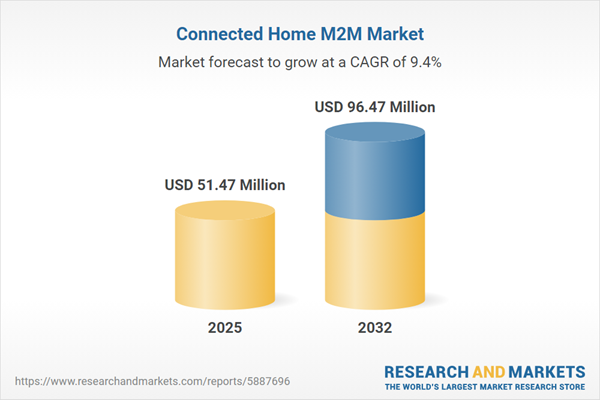Speak directly to the analyst to clarify any post sales queries you may have.
The connected home M2M market is emerging as a transformative force in enterprise automation, empowering organizations to streamline device orchestration and integration. As digital infrastructures evolve, enterprises recognize the strategic role of seamless connectivity in achieving operational agility and responding to user and regulatory demands.
Connected Home M2M Market Snapshot
The connected home M2M market demonstrates sustained momentum across residential, hospitality, and commercial domains, supported by steady growth from USD 47.08 million in 2024 to USD 51.47 million in 2025, and projected to reach USD 96.47 million by 2032. This trajectory reflects a robust 9.38% compound annual growth rate over the projected period. Market expansion is fueled by investments in cloud computing, edge technologies, and predictive analytics. Organizations differentiate through integrated digital services, enhanced interoperability, and agile responses to evolving security and compliance requirements. Go-to-market initiatives increasingly leverage strategic partnerships and regionally tailored models to address local regulatory shifts and customer expectations.
Scope & Segmentation: Connected Home M2M Market
This analysis supplies in-depth segmentation to support informed product development, risk management, and strategic planning specifically for business leaders in the connected home M2M space:
- Communication Technologies: Bluetooth, Wi-Fi, LTE-M, NB-IoT, Z-Wave, and Zigbee enable robust, scalable connectivity for both commercial and residential installations, ensuring dependable operations across environments.
- Applications: Energy management, lighting controls, security systems, entertainment, HVAC automation, and appliance management deliver competitive advantages in efficiency and occupant experience.
- Device Types: Sensors, actuators, controllers, and gateways drive real-time monitoring and responsive automation in dynamic operational settings.
- End Users: Hotels, office managers, and residential users benefit from solutions designed for operational agility, enhanced engagement, and improved service value.
- Distribution Channels: Retail, direct manufacturer sales, system integrators, e-commerce channels, and third-party resellers accelerate procurement and facilitate timely deployment.
- Service Modes: Options include managed subscriptions, on-premises support, and flexible pay-per-use formats, giving organizations adaptability as requirements evolve.
- Regional Coverage: Deployments in the Americas, Europe, Middle East & Africa, and Asia-Pacific are shaped by local regulations and specific market needs.
- Company Developments: Key and emerging players allocate substantial investment toward enhanced wireless interoperability, driving rapid integration and ecosystem advancement in the connected home M2M sector.
Key Takeaways for Senior Decision-Makers
- Adopting cloud-native architectures allows organizations to create modular, continually optimized M2M solutions, delivering operational resilience as business objectives evolve.
- Edge-based artificial intelligence enhances device automation and empowers context-aware responses for increased efficiency and tailored experiences.
- Working with open device standards broadens integration capabilities and fosters collaborative product development across complementary digital offerings.
- Engaging with sectors such as utilities, construction, and communications extends solution applicability and aids in navigating complex regulatory environments for multi-industry adoption.
- Advanced encryption and refined data security boost client confidence while supporting compliance in sensitive operational contexts.
- Flexible sourcing strategies and adaptive inventory management help organizations mitigate disruptions tied to supply constraints or regulatory shifts, safeguarding business continuity.
Tariff Impact: Navigating Regulatory Changes
The deployment of new U.S. tariffs in 2025 introduced additional complexity into the connected home M2M device supply chain. In response, enterprises prioritized nearshoring, deepened local supplier relationships, and improved inventory management processes. These initiatives supported operational resilience and managed costs amidst regulatory adjustments affecting the industry landscape.
Methodology & Data Sources
This report consolidates findings from primary interviews with device manufacturers, service providers, and market users, integrating leading research, legal assessments, and targeted patent reviews. This comprehensive approach offers senior executives reliable strategic intelligence and risk insights.
Connected Home M2M Market: Why This Report Matters
- Clarifies critical risks and future growth opportunities, serving as a strategic framework for B2B investment decisions and deployment plans.
- Provides insight into emerging regulatory trends and adoption patterns, enabling effective partnerships and resource optimization.
- Equips organizations to navigate digital transformation and compliance shifts, maintaining focus on user-centric operational outcomes.
Conclusion
Connected home M2M initiatives empower organizations to achieve greater agility and actionable visibility. Access to current market intelligence supports effective, timely responses to evolving regulatory and technology challenges.
Additional Product Information:
- Purchase of this report includes 1 year online access with quarterly updates.
- This report can be updated on request. Please contact our Customer Experience team using the Ask a Question widget on our website.
Table of Contents
3. Executive Summary
4. Market Overview
7. Cumulative Impact of Artificial Intelligence 2025
Companies Mentioned
The companies profiled in this Connected Home M2M market report include:- Quectel Wireless Solutions Co., Ltd.
- Fibocom Wireless Inc.
- Sierra Wireless, Inc.
- u-blox Holding AG
- Telit Communications PLC
- Thales S.E.
- Huawei Technologies Co., Ltd.
- Sequans Communications S.A.
- Neoway Technology Co., Ltd.
- MultiTech Systems, Inc.
Table Information
| Report Attribute | Details |
|---|---|
| No. of Pages | 190 |
| Published | October 2025 |
| Forecast Period | 2025 - 2032 |
| Estimated Market Value ( USD | $ 51.47 Million |
| Forecasted Market Value ( USD | $ 96.47 Million |
| Compound Annual Growth Rate | 9.3% |
| Regions Covered | Global |
| No. of Companies Mentioned | 11 |









